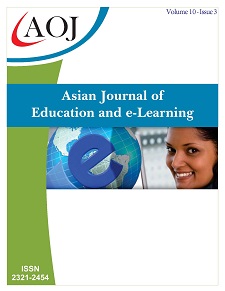Utilization of Instructional Materials Developed by the Mathematics Teachers in the Province of Sorsogon, Philippines
DOI:
https://doi.org/10.24203/ajeel.v10i3.7045Keywords:
Utilization, Development, Instructional MaterialsAbstract
Development and utilization of teacher-made instructional materials in local public schools in the Philippines has taken an increase of demand especially during the implementation of the distance education- blended learning modalities in response to the Pandemic. However, in rural provinces, this remains a big challenge. This study investigates the utilization of instructional materials developed by mathematics teachers in public secondary schools in the province of Sorsogon, Philippines. About fifteen teacher-authors and IM developers from different districts and municipalities across the province are the respondents of this study. The researcher made use of mixed method in the analysis and treatment of data. Findings reveal that mathematics teachers developed and utilized instructional materials that are very limited for classroom consumptions in the Division of Sorsogon. It further concludes that teachers encountered difficulty in utilizing instructional materials.
References
Bassey, S. B, et.al. (2010, June). Developing an instructional material using a concept cartoon. Asia-Pacific Forum on Science Learning and Teaching,.
Bugler, S. M.-G. (2017, March 11). How Teachers Judge the Quality of INstructional Materials. Retrieved from WestEd: https://www.wested.org/wp-content/uploads/2017/03/resource-selecting-instructional-materials-brief-1-quality.pdf
Cadelina, M. (2006). Investigating Students’ Attitude towards Learning Mathematics. International Electronic Journal of Mathematics Education.
Calaluan, H. (2018). A Multiple Case Study of College-Contextualized Mathematics Curriculum. MathAMATYC Educator, 9(2), 49-55. Retrieved from http://www.amatyc.org/?page=MathAMATYCEducator.
Cubillas, T. (2020). Contextualized Learning Material (CLM) in Developing Conceptual Understanding of Grade 7 Mathematic. International Journal of Scientific and Research Publications (IJSRP), 9.
Hizon, I. R. (2018, October 13). The Importance of Instructional Materials. Press Reader.
Kim S, Raza M, Seidman E. Improving 21st-century teaching skills: The key to effective 21st-century learners. Research in Comparative and International Education. 2019;14(1):99-117. doi: HYPERLINK "https://doi.org/10.1177/1745499919829214"10.1177/1745499919829214
Lagata, T. (2016). Characteristics of A Good Instructional Materials. Scribd, 1.
Marasigan, Josephine. (2020). Validating and Utilizing an Outcomes-Based Education (OBE) Student Teaching Manual in a State University in the Philippines. Indian Journal of Science and Technology. 13. 743-755. 10.17485/ijst/2020/v13i07/148722.
Nyawira, W. J. (2015, January). Challenges Facing Teachers in Utilizing Instructional Resources when teaching mathematics in public secondary schools in nairobi county, kenya. retrieved fromhttps://irlibrary.ku.ac.ke/bitstream/handle/123456789/13244/challenges%20facing%20teachers%20in%20utilizing%20instructional%20resources%20when%20teaching%20mathematics%20in%20public%20secondary%20schools%20in%20nairobi%20county,%20kenya.pdf;jsessionid=8d
Samuel, Amadioha. (2009). The Importance of Instructional Materials in Our Schools An Overview. New Era Research Journal of Human, Educational and Sustainable Development, 2. 61-63.
Stephen, D. U.-A. (2015). Problems of Improvising Instructional Materials for the teaching and learning of physics in Akwa Ibom State secondary schools, Nigeria. British Journal of Education, 27.
Tety, J. L. (2016). Role Of Instructional Materials In Academic. Core.
Urbandale Community School District. (2021). Retrieved from Brandale Education Foundation: https://www.urbandaleschools.com/policy/article-600-educational-program/627-instructional-materials-selection-inspection-and-reconsideration/
Valdez, J. (2018, February 16). Characteristics of Good Materials. Retrieved from Padlet: https://padlet.com/usbetsu/9yfd682mxee6
Yap, J. (2012, August 6). OPINION: Improving The Quality Of Education In The Philippines. Asian Scientist.
Downloads
Published
Issue
Section
License
Copyright (c) 2022 Albert C Mendiola, Aldrin John J. Estonanto

This work is licensed under a Creative Commons Attribution-NonCommercial 4.0 International License.
- Papers must be submitted on the understanding that they have not been published elsewhere (except in the form of an abstract or as part of a published lecture, review, or thesis) and are not currently under consideration by another journal published by any other publisher.
- It is also the authors responsibility to ensure that the articles emanating from a particular source are submitted with the necessary approval.
- The authors warrant that the paper is original and that he/she is the author of the paper, except for material that is clearly identified as to its original source, with permission notices from the copyright owners where required.
- The authors ensure that all the references carefully and they are accurate in the text as well as in the list of references (and vice versa).
- Authors retain copyright and grant the journal right of first publication with the work simultaneously licensed under a Attribution-NonCommercial 4.0 International that allows others to share the work with an acknowledgement of the work's authorship and initial publication in this journal.
- Authors are able to enter into separate, additional contractual arrangements for the non-exclusive distribution of the journal's published version of the work (e.g., post it to an institutional repository or publish it in a book), with an acknowledgement of its initial publication in this journal.
- Authors are permitted and encouraged to post their work online (e.g., in institutional repositories or on their website) prior to and during the submission process, as it can lead to productive exchanges, as well as earlier and greater citation of published work (See The Effect of Open Access).
- The journal/publisher is not responsible for subsequent uses of the work. It is the author's responsibility to bring an infringement action if so desired by the author.


